7+ Sample Quarterly Business Report
-
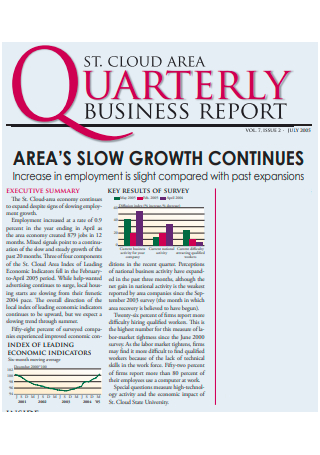
Quarterly Business Report Template
download now -
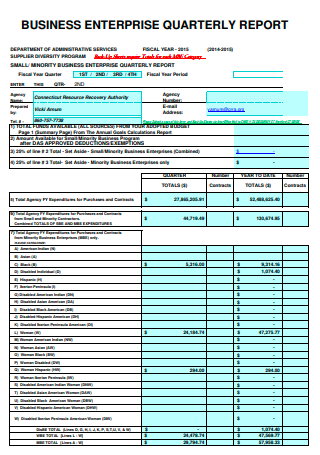
Quarterly Business Enterprise Report
download now -
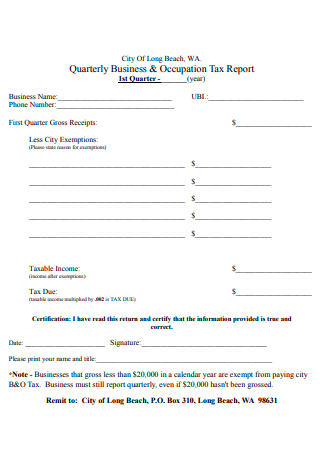
Quarterly Business and Occupation Tax Report
download now -
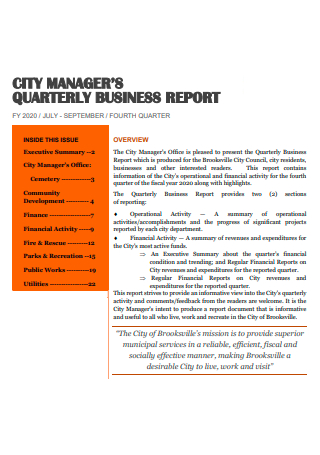
Managers Quarterly Business Report
download now -
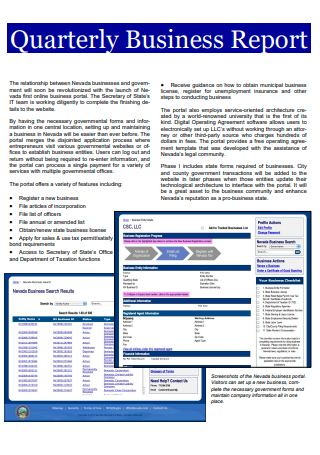
Quarterly Business Report in PDF
download now -
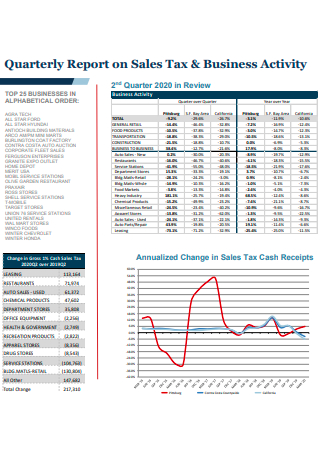
Quarterly Business Activity Report on Sales Tax
download now -

Quarterly Business and Development Report
download now -
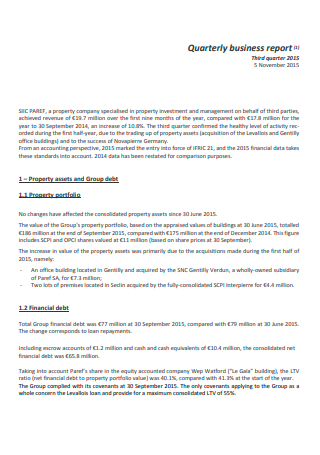
Printable Quarterly Business Report
download now
FREE Quarterly Business Report s to Download
7+ Sample Quarterly Business Report
What IS a Quarterly Business Report?
Types of Business Reports
How To Make a Quarterly Business Report
FAQs
What is the importance of doing a quarterly business report?
What are some of the other types of business reports?
What are the characteristics of a good business report?
What IS a Quarterly Business Report?
A quarterly business report, also known as a quarterly business review, is a presentation business report that assesses your relationship with your customers, looks into how your business is positioned in the market and reviews the past quarter’s marketing and sales plans performances to see if it were able to meet your companies goals and objectives. The business report focuses on the key relationship between vendor and client or customer. It is a roadmap that leads both parties on how to strengthen their business relationship by looking at the business’s past performance. A SWOT analysis model can be applied in this case. SWOT is done by looking at the business’s Strengths, Weaknesses, Opportunities, and Threats aspects. Strengths are those aspects or features of the business that made it unique, stand out and win over the market and competition.
Strength could be in the form of good marketing and sales strategies, unique brand concept, strong market position, and so on. Weaknesses are those aspects of the business that need to improve, and/or lack support. Those could be lack of manpower or field sales personnel, lack of resources or equipment, lack of sales training, et cetera. Opportunities are those aspects that the business could use to help achieve its marketing and sales objectives. These could be using the latest trend in advertising such as social media marketing, email marketing, or even search engine optimization or SEO marketing. Threats are those that hinder, potentially harm, or put at risk the business operation. These could include strong competition presence in the area, lack of funding, or even lack of latest technology software or training. The SWOT analysis overall helps specifically identify which area of the business and customer relationship needs to be improved, and which area needs to be continued and enhanced as well. This is also an opportunity to bring up opportunities to further strengthen the relationship through the creation of new and innovative business strategies.
Types of Business Reports
Believe it or not, business reports also come in different shapes and sizes. Depending on the need, reports are made flexible enough to meet the type of business goals and objectives and are made depending on who the business report is to be presented for. The details inside a business report may also vary according to the type of business. Regardless of the type, business reports share the same purpose, which is to effectively send out the message of how the business was able to evaluate a certain issue, circumstance, or operation, and their planned strategies on how they would set out in achieving goals, objectives, or creating solutions to address any business issues. Below are some of the following common types of business reports.
How To Make a Quarterly Business Report
A quarterly business report, as we have mentioned, touches on the relationship between a business and its customers. Similar to customer management, the report aims to provide a look into the past quarter’s business performance, and how the performance impacts the customers or the stakeholders. It shows what went well, what went wrong, and what needs to be improved opportunities and aspects. A quarterly business report, again, has to be flexible to meet the purpose of why the report is to be made and presented in the first place. Although there are no strict formats in creating a business report (not unless one has been given), to be effective, the report should at least contain the following essential elements.
-
1. Business Overview
Similar to an executive summary, a business overview provides the reader with background information about the business, what it does and how long it has been in existence. It also provides what are the business’s goals, KPIs, and objectives, and a summary or an outline of what were the steps taken to achieve those goals, KPIs, and objectives. Oftentimes, the business overview contains the mission and vision statement. The mission statement described what is the purpose or reason for the creation of a quarterly business report, in this case, to strengthen or further improve customer relationships. The vision statement states what the business hopes to achieve with its customer relationship, usually in a given time frame.
-
2. Performance Review
This section delves deeply into the business’s sales and marketing performance from the past quarter. For the sales performance, it assesses the sales planning and sales strategies that were implemented to help accumulate sales revenue. The sales performance is often presented as what were the sales goals, what were the sales strategies implemented to achieve those goals, and what were the results. It also emphasizes the sales achievement and sales challenges that were met along the way. The marketing performance review touches on how well the marketing team positions the business in the market and attracts potential customers, and converts them into buying customers. It provides detail on what were the marketing strategies used, the impacts of their branding concept, and the conversion rate of potential customers and customers who are loyal to a different brand. Another part of the performance review can also do a competitor analysis, just like doing a market analysis. Competitor analysis is all about who your competitors are during the past quarter, who were the strongest competitors so that this can help you also to analyze current market trends and see opportunities for growth.
-
3. Financial Review
A financial review, similar to a financial planning statement, presents the overall financial condition and outlook of the business. It first presents the capital budget or fundings used in the quarter, goes into what were the related costs and expenses that occurred during the quarter, and then shows what were the sales revenues. Since this report is focused primarily on business-customer or stakeholder relationships, the costs and expenses shown are those that took place during the implementation of the sales and marketing strategies, as well as how much revenue did the company earned per strategy. A financial review can also contain a cash flow statement and a balance sheet. The cash flow statement shows the amount of money coming in and out of the company, while the balance sheet reflects the business assets, liabilities, as well as stakeholders’ investments. The financial review section is a critical part of a quarterly business report since this section will help your customers or stakeholders determine if doing business with you is still feasible or not.
-
4. Future Plans & Programs
Your customers or investors would like to be reassured that the business is doing everything it can to value their inputs to the company. Hence, a business should always be prepared with plans and programs, either to improve existing strategies or to continue and enhance existing business practices. New plans and programs should be created taking a cue from the past quarter’s performance and strategies. To effectively create new plans, following a SMART goal method is advisable. SMART stands for Specific, Measurable, Achievable, Relevant, and Time-bound. A plan should be specific, which means it is identifiable and concise. A plan should also be measurable, something that can be tracked or monitored. Achievable plans are attainable plans, not plans that are next to being mission-impossible planning. Relevant plans are appropriate and applicable to the current time and market, while a time-bound plan should set the tone of urgency for the action to be carried out by having a deadline to it. Note that when planning your new plans and programs, this also meant creating new goals and objectives for the next sales period which, in this case, is the next business quarter.
FAQs
What is the importance of doing a quarterly business report?
Firstly, a quarterly business report helps analyze what went well and what went wrong with its planning and strategies that equates to strengthening the business’s relationship with its stakeholders. If a business puts an effort in being transparent to its stakeholders by creating a business report for them, the stakeholders in turn will feel valued for the business that they’re doing for the company. Having a quarterly business report is also an opportunity to celebrate any achievements or successes the business has, especially when it comes to the achievement of the business’s goals and objectives.
What are some of the other types of business reports?
Other types of business reports are by period business reports, such as the annual, quarterly, or monthly reports; sales and revenue reports; inventory reports; and/or marketing reports. If your business is leveraging the online digital world for marketing or targeting your potential customers, another kind of business report is called a website or social media report. This type of report assesses and evaluates your business’s marketing presence and performance online. Online traffic and online engagement are the focus of this report.
What are the characteristics of a good business report?
A business report should be clear and concise and should be free from multiple interpretations or conclusions. It should be accurate and well-researched, meaning that the facts are taken from reliable sources. The business report should also be created according to the type of audience that will be reading it or to whom it will be presented.
Business reports are not just all about coming up with concepts, ideas, and action plans to meet a business’s goals and objectives. Business reports are also all about assessing, analyzing, and evaluating past performances based on certain metrics, and then creating future plans based on those assessments. That is how important a business report is.
Good thing we have just the right template for you to use if you’re planning on creating a quarterly business report. Our quarterly business report templates are ready-drafted, easy to use, and can be easily accessed at any time. Download one now!
